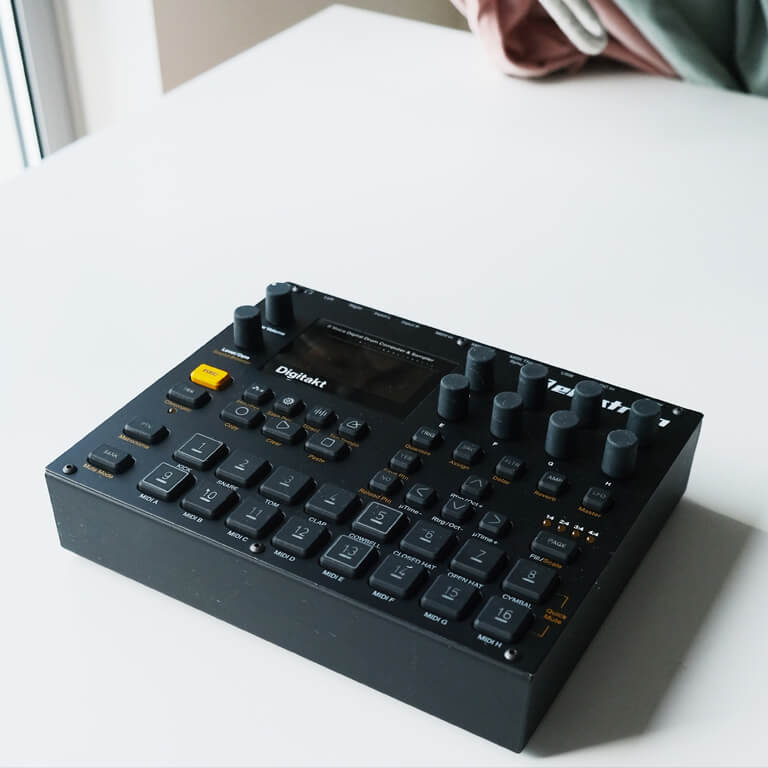So you’re tired of listening to similar-sounding Trap beats over and over again and would rather cook up some head-nodding Old School Hip Hop? Cool, you came to the right place. In this post, you’ll learn 6 essential Boom Bap Drum Patterns. Let’s dive right in!
Note: If you want to make your own Boom Bap drum loops, you certainly need some decent drum hits, so make sure to check out the free “Old School kit” by wavbvkery. It contains 106 royalty-free drum hits, which have been sampled from old vinyl records:
- 25 Hats
- 30 Kicks
- 20 Percs
- 31 Snares
The Classic Boom Bap Drum Pattern
Before we look at the complex patterns, let’s start with the classic one you can find in so many old Boom Bap tracks from the 90s. Set a tempo between 90 – 100 BPM and drag a closed hat into a sampler of your choice. Now make a new MIDI clip and fill out every note in a 1/8 grid.

Next up, add a snare to every second quarter hit. Set your grid to a 1/16 pattern and recreate the following kick pattern. As you can see, some of the notes aren’t perfectly on the grid, which is THE key to achieve this typical Boom Bap groove.

Pro Tip: Instead of drawing in the notes manually, try to record the MIDI clip using a MIDI keyboard or drum pad. This usually results in a more natural feel, since most of the notes won’t be perfectly in time.
So now that you got the classic pattern, let’s take a look at some more interesting variations..
Drum Pattern #1
For the first of our Boom Bap drum patterns, we set the BPM to 80, which is slower than the original Boom Bap. As you can hear, the snare hits on every second quarter hit, but we also added another offbeat hit every bar. In contrast to the classic pattern, every kick note is exactly on the grid. However, some of the notes have a lower velocity setting.
Download MIDIDrum Pattern #2
For the second pattern, we went back to 90 BPM. We moved the offbeat snare slightly to the right side and lowered the velocity. Listening to the kick, you’ll notice that this pattern is closer to the classic one than the first one was. However, some of the notes have still been changed.
Download MIDIDrum Pattern #3
For the third pattern, we removed all of the ghost notes from the snare, except for the last bar, which makes it sound somewhat like a small fill. We also added a bunch of ghost notes to the kick, which makes it almost sound like there’s some scratching involved.
Download MIDIDrum Pattern #4
Here’s the snare just hitting on every second quarter note, without any variations, so all the magic is happening at the kick. Some of the ghost notes are once again not perfectly aligned with the grid and have lower velocity settings than the hard-hitting ones.
Download MIDIDrum Pattern #5
The snare is also quite boring on this one. However, the really interesting part about the fifth drum pattern is that you’d expect a kick to hit on the 3rd bar, which is however left out. Small surprises like this can be quite beneficial to get the listener’s attention back.
Download MIDIBonus Tricks
So looking at the drum loops above we only focused on the kick and snare. However, there’s also a lot you can do with the hats. You could for example replace the hat with a shaker or drag every second note a tiny bit to the right. This can also be achieved using Ableton’s Groove Pool, which is a great alternative, if you don’t have a MIDI pad, to “record” the pattern.
Thirsty for more?
All of the loops above were made using Boom Bap samples taken from “Artifacts”, which comes with 1.98 GB of royalty-free content, including stemmed-out drum loops, drum hits, melodic loops, matching MIDI files, tonal one-shots, and more. It basically contains everything you really need to produce genres like Boom Bap, Old School Hip Hop, or even Lo-Fi, so feel free to check it out, if you’re still searching for a decent production library.


